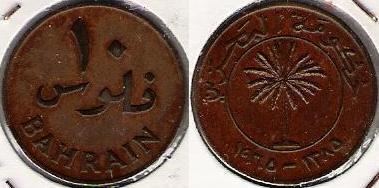Code BHD | ||
 | ||
Symbol .د.ب (Arabic) or BD (Latin) Banknotes BD ⁄2, BD 1, BD 5, BD 10, BD 20 Coins 5, 10, 25, 50, 100, BD ⁄2 (500 fils) | ||
The dinar (Arabic: دينار Dīnār Baḥrēnī) (sign: .د.ب or BD; code: BHD) is the currency of Bahrain. It is divided into 1000 fils (فلس). The name dinar derives from the Roman denarius. The dinar was introduced in 1965, replacing the Gulf rupee at a rate of 10 rupees = 1 dinar. The Bahraini dinar is abbreviated .د.ب (Arabic) or BD (Latin). It is usually represented with three decimal places denoting the fils.
Contents
Coins
In 1965, coins were introduced in denominations of 1, 5, 10, 25, 50 and 100 fils. The 1, 5 and 10 fils were struck in bronze, with the others in cupro-nickel. The 1 fils coin was not produced after 1966 and no longer circulates. In 1992, brass replaced bronze in the 5 and 10 fils and a bimetallic 100 fils coin was introduced. A bimetallic 500 fils followed in 2000.
The Central Bank of Bahrain discontinued the Bimetallic 500 fils after the revolution of Bahrain on 14 Feb 2011.
For a wider history surrounding currency in the region, see The History of British Currency in the Middle East.
Fixed exchange rate
In December 1980, the dinar was officially pegged to the IMF's special drawing rights (SDRs). In practice, it is fixed at $1 USD = 0.376 BD, which translates to approximately 1 BD = $2.65957 USD and, consequently, almost 10 Saudi Arabian riyals. This rate was made official in 2001. Before Malta's adoption of the euro on 1 January 2008, it was the third-highest-valued currency unit after the Kuwaiti dinar and Maltese lira. After Malta adopted the euro, the dinar became the second highest-valued currency unit.
Note: Rates obtained from these websites may contradict with pegged rate mentioned above
